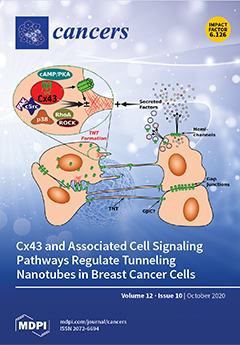Open AccessArticle
Evolution of Mutational Landscape and Tumor Immune-Microenvironment in Liver Oligo-Metastatic Colorectal Cancer
by
Alessandro Ottaiano, Michele Caraglia, Annabella Di Mauro, Gerardo Botti, Angela Lombardi, Jerome Galon, Amalia Luce, Luigi D’Amore, Francesco Perri, Mariachiara Santorsola, Fabienne Hermitte, Giovanni Savarese, Fabiana Tatangelo, Vincenza Granata, Francesco Izzo, Andrea Belli, Stefania Scala, Paolo Delrio, Luisa Circelli and Guglielmo Nasti
Cited by 31 | Viewed by 4443
Abstract
Genetic dynamics underlying cancer progression are largely unknown and several genes involved in highly prevalent illnesses (e.g., hypertension, obesity, and diabetes) strongly concur to cancer phenotype heterogeneity. To study genotype-phenotype relationships contributing to the mutational evolution of colorectal cancer (CRC) with a focus
[...] Read more.
Genetic dynamics underlying cancer progression are largely unknown and several genes involved in highly prevalent illnesses (e.g., hypertension, obesity, and diabetes) strongly concur to cancer phenotype heterogeneity. To study genotype-phenotype relationships contributing to the mutational evolution of colorectal cancer (CRC) with a focus on liver metastases, we performed genome profiling on tumor tissues of CRC patients with liver metastatic disease and no co-morbidities. We studied 523 cancer-related genes and tumor-immune microenvironment characteristics in primary and matched metastatic tissues. We observed a loss of
KRAS and
SMAD4 alterations and a high granzyme-B+ T-cell infiltration when the disease did not progress. Conversely, gain in
KRAS,
PIK3CA and
SMAD4 alterations and scarce granzyme-B+ T-cells infiltration were observed when the tumor evolved towards a poly-metastatic spread. These findings provide novel insights into the identification of tumor oligo-metastatic status, indicating that some genes are on a boundary line between these two clinical settings (oligo- vs. poly-metastatic CRC). We speculate that the identification of these genes and modification of their evolution could be a new approach for anti-cancer therapeutic strategies.
Full article
►▼
Show Figures






